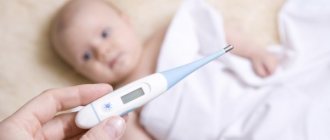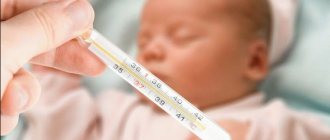Every person knows that normal body temperature is 36.6 degrees. But is this true for newborns and infants? Of course not, because after birth, babies go through a long journey of adaptation to the environment. For 9 long months, the baby’s home was his mother’s womb, but after birth he will now have to independently adapt to everything that surrounds him. The child’s body adapts gradually, and the process of thermoregulation improves over the course of 1 year. What is considered the normal temperature for a child at 4 months? We will learn about this in the material.
Causes of low-grade fever in children without symptoms
To talk about the causes of fever in children, it is necessary to define what is normal. It is generally accepted that an ideal thermometer reading falls within the range of 36.4 - 36.6 degrees. But not all children have this. A variation in body temperature values from 35.6 to 36.9 degrees is not considered pathological. And for infants, the permissible upper limit is 37.5 degrees.
The thermometer level rises asymptomatically for various reasons. All of them can be divided into natural and pathological. The former usually do not have additional symptoms and do not require treatment with medications. It is enough to eliminate the provocateur and the child’s condition will return to normal. The latter often have additional symptoms and require medical attention.
Natural reactions of the body to external stimuli
If a child has a temperature of 37.2-37.4 without symptoms, then it may be caused by excessive physical activity. Remember what the baby did before the measurement?
If the baby was jumping, running, playing active games, or even talking loudly, then this could be the reason.
The measurement should not be taken immediately after activity, as its results cannot be considered indicative. Diagnosis of temperature is carried out in the child’s armpit only after 20-30 minutes of rest. A slight increase in values can occur even after eating, especially hot food and with a lot of spices. Other natural causes of low-grade fever include:
- warm clothes and being in a hot room (especially in children of the first year of life);
- eruption of baby teeth (can occur periodically up to 2 - 2.5 years);
- exposure to the sun, heat stroke (can occur in children of all ages).
An increase in a child's body temperature to 37.1-37.5 often occurs due to taking certain medications. Antibiotics used to treat bacterial diseases can cause an increase in the thermometer level on the first day due to massive death of bacteria and severe intoxication. Immunomodulators also sometimes cause a slight subfebrile condition, as they stimulate the body's defense reaction. If a child’s temperature is 37.2-37.5 without symptoms, and we are talking about a newborn, then this value is considered normal. But a further increase already indicates a pathological process.
When should you call an ambulance (doctor)?
The child must be shown to a specialist when the first symptoms of the disease appear. If on the third day after the start of treatment the child still has a temperature of 38, you should call an ambulance and go to the hospital.
It is necessary to stop using medications and go to the hospital if a one-year-old child experiences:
- hives;
- itching;
- cough;
- swelling of the limbs.
If in babies under 3 months of age who suffer from heart pathologies and convulsions, the readings on the thermometer exceed 37.5, you should immediately call an ambulance and show the child to a doctor.
Loading …
What diseases can cause fever?
The fact that a child has a temperature of 37.7-37.9 without symptoms may also indicate a pathological process in the body. Its origin can be very different. Most often, children experience low-grade fever due to a cold, viral or bacterial infection. These include:
- pharyngitis and nasopharyngitis;
- rhinitis, sinusitis, sinusitis;
- eustachitis, otitis media;
- tonsillitis;
- laryngitis, tracheitis;
- bronchitis, pyelonephritis.
It is these diagnoses that are most often attributed to children with an increase in temperature to 37.9 without additional symptoms. Other signs may simply be invisible to parents. For example, with otitis media the ear hurts, and with tonsillitis the throat hurts, but the child cannot correctly explain his condition.
During viral infections, the child’s body tries to cope on its own by producing valuable interferon. This process causes an increase in temperature, but there are no additional cold symptoms yet.
If the virus turns out to be stronger, they will appear only in a few days.
Low-grade fever in the range of 37.6-37.8 without other signs is observed in infectious diseases such as rubella, chickenpox, and roseola. Initially, the child has a fever, and there are no additional symptoms. Only after 2-4 days does a rash appear, which becomes the main symptom of the disease.
Less commonly, a child is diagnosed with pathologies that can occur with a higher temperature without additional manifestations:
- lesions of the urinary system (pyelonephritis, cystitis, urethritis);
- parasitic infections (toxoplasmosis, brucellosis, helminthiasis);
- tumors (benign or oncological);
- endocrine diseases;
- damage to the lymphatic system;
- autoimmune diseases (lupus erythematosus, arthritis).
Is it worth lowering the temperature?
As body temperature rises, the body produces a protein called interferon, which helps fight infection. By lowering the temperature, the immune system is prevented from working properly.
When making a decision to lower the temperature, you need to focus primarily on the child’s condition.
You cannot do without medication if your baby:
- cries;
- breathing problems appear;
- chills are noted;
- limbs are pale and cold
At the same time, when lowering the temperature, you should not try to reach the normal level of 36.6; it is enough to reduce it by 1-1.5 degrees so that the child feels better.
In three cases, it is necessary to lower the temperature without waiting for the 38 mark:
- children with neurological pathologies;
- infants up to 3 months;
- children with chronic heart disease.
If, if the temperature rises to 38.5, the child looks relatively normal and there are no other symptoms, you should not give the baby antipyretics. The exception is an infant under 3 months.
The video talks about cases when you can lower a child's temperature. Filmed by the Doctor Komarovsky channel.
Temperature tail after illness
The peculiarity of this hyperthermia is that the thermometer level usually becomes higher in the evening. At the same time, in the morning it returns to normal on its own, and during the day the child feels well and does not complain of fever.
When a child has a temperature of 37.1-37.3 after an illness, it is called residual. Often this occurs after illnesses that are severe or moderate in severity.
A child may have a temperature of 37 after influenza, ARVI, chickenpox, rubella, lymphadenitis, otitis, pyelonephritis, tonsillitis and intestinal infection.
Low-grade fever in these cases may persist for another 1-2 weeks. Less often it lasts a month.
Many parents are wondering: is it necessary to take any action if in the evening the child has a temperature of 37.4 without symptoms? Doctors answer it negatively. It is not worthwhile to bring down such a temperature and give any antipyretic or other medications to the child.
The only thing doctors can recommend is taking vitamin regenerative complexes designed to strengthen children's immunity. If the baby’s condition still causes serious concern among parents, then this is a reason to contact a pediatrician and get tested, after which an accurate diagnosis will be made.
Features of treatment for asymptomatic fever
When a child has a temperature of 37.1-37.9 without symptoms, is it worth giving the baby any medications or antipyretic medications, or maybe you should start right away with antibiotics? More and more often you can find similar requests on the Internet.
Parents want to help their child on their own, so as not to seek help from doctors. It is worth immediately warning that any self-medication may be incorrect. As a result, you will not only not help the child, but also cripple his health. In the treatment of low-grade fever, you need to follow the basic rules.
- Do not use antipyretics until the body temperature reaches 38.5 degrees. An exception can be made only for children with neurological diseases, hypoxia or birth injuries. Such children should be given an antipyretic when the thermometer approaches 38 degrees.
- If you are using antipyretics, then choose only those drugs that are intended to treat a child. Children from the first month of life can be given Cefekon D suppositories, from three months it is preferable to use Ibuprofen, Calpol, Panadol syrups, and from 6 years old Nurofen and Paracetamol tablets are allowed. Each drug indicates an individual dosage corresponding to the child’s age. Pay special attention to this.
- Antipyretic drugs are symptomatic. They relieve low-grade fever, but do not in any way affect the cause of its occurrence. Therefore, they do not provide treatment as such. To treat a child with fever without additional symptoms, you need to see a doctor and find out why it appeared.
- Any therapeutic measures should be started only after the doctor allows it. Be sure to repeat the measurement of your baby's body temperature. It is possible that it will normalize within an hour after recording elevated values.
If this happened and the thermometer level did not increase further, then you can be sure of your child’s complete health. You should seek emergency help from a medical facility if the temperature continues to rise rapidly or the young patient’s condition is aggravated by additional symptoms.
Jun 17, 2017Yulia Astafieva
Parents are often worried when they discover that their infant has a temperature of 37 degrees or even higher. An elevated temperature is perceived as a sign of illness; it seems that the baby requires mandatory and immediate treatment.
A fever in a very young child is indeed a sign of a viral illness and, along with other symptoms, can alert parents that their baby needs medical attention, but there are other causes of fever. A slightly elevated temperature, compared to adults, of 37 degrees or slightly higher: 37.1 - 37.5 - is not considered by pediatricians to be something serious unless there are other signs of illness: the child is active, has a good appetite, is not restless and eats well.
This body temperature is due to the fact that heat exchange mechanisms in infants are still imperfect and continue to develop up to a year after the birth of the child.
First aid for fever
By following these steps, you can reduce your temperature without antipyretics:
- Undress the child. When an increase in body temperature is associated with overheating, it is necessary to undress the child to a comfortable temperature. If we are talking about a baby, you should remove the diaper.
- Rubdowns. Rubbing with a vinegar solution will help reduce the temperature - 1 liter of warm water per 1 tablespoon of vinegar.
- Drinking regime. Babies are often put to the breast, and older children are sung with acidified water, linden and raspberry decoction with the addition of honey.
- Calm. During the period of illness, the child needs to be provided with the most comfortable conditions. Hysterics and tears should not be allowed, as this can have a detrimental effect on future well-being.
Antipyretic drugs
Below are lists of the most popular antipyretic drugs for treating children from birth to adolescence.
From birth and for children from one year old
The list of drugs recommended for the treatment of infants is presented below.
School and adolescence
Most often, antipyretic drugs similar to those for infants are prescribed with a higher dosage and in a different form of release.
Rules for the use of drugs
Only a doctor has the right to prescribe a treatment based on an initial examination and other diagnostic measures.
When choosing a drug and determining the dosage, it is important to consider:
- age;
- weight;
- manifestation of allergic reactions;
- other related factors.
For babies suffering from teething and poor heat tolerance, doctors prescribe medications in the form of:
- syrups;
- suspensions;
- candles.
What should be the body temperature of a healthy 5 month old baby?
What should be the body temperature of a healthy 5 month old baby?
- My child's normal temperature was 37.3. An immunologist, during a consultation, said that in children under 1 year of age, the norm is considered to be up to 37.5, provided that the child sleeps well, eats, and does not worry. We were given the same thing at lectures on pediatrics when I was a medical student. school For my child, this was due to the fact that the child is loose, the blood vessels are close + very mobile.
- like a normal adult: 36.6 probably
- To determine what temperature is normal for an infant, you need to measure it several days in a row at the same time, when the child is healthy and calm. In the first year of a child’s life, elevated temperature should not be considered a deviation from a temperature of 36.6°C, but a deviation from the figure you set. The normal temperature of a child under one year old is not 36.6#730;C, as is commonly believed, but fluctuates by 0.5#730;C – 1.0#730;C, rising in the evening. When measuring the temperature in the armpit, the normal value is taken to be 36.5#730;C – 37.5#730;C: the maximum normal temperature (rectal) is on average 37.6#730;C – 37.8#730;C . Rectal temperature is usually 0.5#730;C – 0.6#730;C higher than axillary temperature. It must be remembered that a temperature above 38#730;C, wherever it is measured, in most children corresponds to febrile; the difference in tenths of a degree does not matter much in this case. But don’t worry if in the evening your child’s temperature rises to 37.3#730;C – 37.5#730;C. Regulation of body temperature is achieved through a balance between heat production and heat transfer. The body generates heat by oxidizing (burning) carbohydrates and fats in tissues, especially when muscles work. Heat can be lost when the skin cools: losses increase with the evaporation of sweat and dilation of skin vessels.
- 37 is normal for babies under one year old. In general, it is better to consult with a pediatrician!
- If you have a low-grade fever, it’s okay, the main thing is that it’s not less than 36.6.
- Like an adult, in the evening, against the background of activity, it can normally be 37. Not true! 37.0-37.5 is nonsense!
- up to 37.2 is normal.
- not true! 37.0-37.5
- In children under 1 year of age, a temperature of up to 37.5 can be considered normal (unless, of course, it is accompanied by any catarrhal or other inflammatory symptoms). It is important to know that if you measure the pace. immediately after sleeping, feeding, crying, then it will definitely be higher than normal levels.
- 36.5 is like any normal person, but 37 is already a temperature, you can’t just bring it down, the temperature only goes down from 38 in children
- 37 is normal.
- Same as adults
Home Children's health What should be the body temperature of a healthy 5-month-old baby.
Temperature in a child under one year old
Every pediatrician knows that thermoregulation in a newborn and, accordingly, his body temperature is significantly different from the heat exchange of an adult. For many babies, the first few days after birth the temperature can remain at 37.3-37.4 degrees. Over time, the indicators decrease to the usual 36.6 degrees, usually this period takes about a year.
But, be that as it may, an increase in temperature can also be a symptom of a serious illness. Therefore, young mothers need to carefully monitor temperature fluctuations and know certain childhood characteristics that can affect the thermometer readings.
Normal temperature in a newborn baby
A baby's temperature of 37 degrees is considered normal, especially if the baby is alert and active. Moreover, it can increase even more if the child has just eaten, cried, or is not dressed for the weather. Also, you should not measure your baby’s temperature immediately after he wakes up or returns from a walk. And in this case, the figures may be somewhat overestimated.
The temperature is especially unstable in babies under three months. Depending on environmental conditions at this age, children quickly overheat or become hypothermic.
To find out what body temperature is considered normal for each specific child under the age of one year, it is necessary to regularly measure it several times a day, at the same time for a certain period. The data obtained can be recorded in a special diary. This will allow you to immediately suspect something is wrong if the temperature rises above normal.
In pediatric practice, the following indicators are considered normal for children from 1 month to 5-7 years:
- In the armpit
up to 37.3 degrees. - Rectal temperature
can reach 37.5 degrees. - Oral
– 37.2 degrees.
In addition, it is very important to learn how to correctly measure the temperature of a child under one year old.
How to measure a baby's temperature?
It is best to measure a newborn's temperature while sleeping. To do this, you need to place the baby on its side and place the thermometer in the armpit.
Currently, parents can use not only a mercury thermometer (which, even in comparison with the latest innovations, remains the most reliable), but also an electronic, infrared one. pacifier thermometer and other modern devices. Of course, they greatly facilitate the process itself, but the results may not be entirely correct.
It is worth using an electronic or infrared thermometer if the child has a fever and the temperature needs to be measured as quickly as possible.
How to reduce the temperature of a child under one year old?
If there is a significant increase in temperature caused by infectious agents or viruses, it is necessary to act according to the circumstances. Doctors do not recommend taking antipyretics. if the thermometer shows 38.5 or lower. This temperature is considered protective and indicates that the body is actively fighting germs. However, this does not apply to those cases when the baby experiences convulsions due to an increase in body temperature, he constantly cries and is capricious, or in the presence of diseases of the cardiovascular and respiratory systems. In such a situation, it is much safer to immediately give the child medicine in order to avoid unwanted consequences.
It is also better to ignore the recommendations and take an antipyretic drug in advance if the temperature begins to rise rapidly at night. Because mom is also a person and can simply fall asleep and not notice when the temperature starts to go off scale.
As for ways to reduce temperature, there are several options:
- Syrup.
If the temperature needs to be brought down as quickly as possible, and the child is not vomiting, this type of medicine can be given. It begins to act 20-30 minutes after administration. - Suppositories
are considered a more gentle remedy for the gastrointestinal tract, but they exert their effect no earlier than 40 minutes after administration. But when a child refuses to drink the syrup, or vomits it immediately after taking it, suppositories are a wonderful alternative.
If you gave the medicine just when the temperature was rapidly rising, then after taking the antipyretic drug, it may rise for some time (up to an hour), or remain at a high level.
If there is no positive result, you must immediately call an ambulance.
Good evening.. Say, be kind to the child, 2.5 months yesterday and 5 years old, she cried a lot, didn’t sleep, started sleeping, called out for the Swede, the stinks arrived, and the child was burning hot, they injected the nose with diphenhydramine, measured the temperature at 37.5 pick it up at the doctor's office, Then the baby fell asleep. When the pediatrician arrived home, he said that everything was fine.. And with Sweden there was a viral infection. Ale today, don’t cry, the temperature is 37, it’s normal.
Viola Ukraine, Radivilov
And my daughter has had it since she was 5-6 months old. It started on 37. - 37.4 and the urine and blood tests are excellent and continue to this day (8 months) What should I do? There is no shame in contacting our pediatrician!
Elena Dushko Ukraine, Kyiv
Please tell me, my child is 3 months old and her body temperature is 34, but she behaves normally
Guest
Check the blood for sterility, we had staphylococcus in the blood, the temperature was the same as yours.
Guest
When the heat started, my baby’s temperature fluctuated from 36.6 to 37.2, no more symptoms. She also sometimes grunts, probably from the high air temperature. The norm for children of the first year is up to 37.5
Guest
At first, our 4-month-old daughter had a red throat, we smeared it with chlorophyllipt. and on day 2 the temperature rose to 38. What should I do? She behaves normally.
Guest
Elena, is your throat okay? I had this temperature with chronic tonsillitis. I cured my tonsils and everything is ok. True, if I catch a cold, it all starts again (((
Features of temperature measurement
Before talking about the fact that the baby has an elevated temperature, you first need to make sure that the measurement is carried out correctly. The classic option of measuring temperature under the arm is popular, but this method is the most inappropriate for children, especially if measurements are taken using a mercury thermometer. The main disadvantage of a mercury thermometer is that it is not safe, since using it can damage the glass flask containing dangerous mercury.
It is important to know! For children, it is recommended to give preference to electronic thermometers. The main advantage of electronic thermometers is absolute safety, but there is also a drawback - the error of readings.
Having decided on a thermometer, you should also know that you can measure the temperature not only under the arms, but also in the following places:
- in the rectum;
- in the oral cavity;
- in the ear.
Temperature values in the ear and oral cavity are measured using special thermometers. These two methods allow you to obtain the most accurate values of a child’s body temperature. For a 4-month-old baby, it is recommended to use the option of measuring fever using a thermometer in the form of a pacifier. The cost of such a device is slightly higher than a regular one, but parents will be able to take temperature measurements at the required time without any problems. For 4-month-old infants, the temperature in the oral cavity is 37-37.4 degrees, which is normal.
The following factors influence the correctness of temperature measurements and its values:
- measurement method, since depending on the chosen method, the thermometer readings will differ;
- the activity of the baby, because the older the baby becomes, the more active he is, and this directly affects the temperature value;
- emotional state, since calm kids are not as hot as capricious and overexcited ones;
- time when the measurement is taken.
Parents are accustomed to measuring their children's temperature while they are awake. At the same time, it is important to know that measurements will be most accurate if they are carried out while the baby is sleeping. It is not recommended to take measurements during or after feeding, as well as after waking up and during overexcitation, since the data obtained will be overestimated. Such data cannot be used to judge the state of health, so it is recommended to wait until the baby falls asleep.











